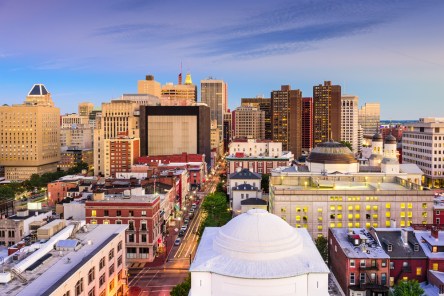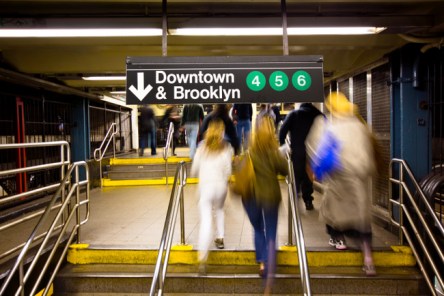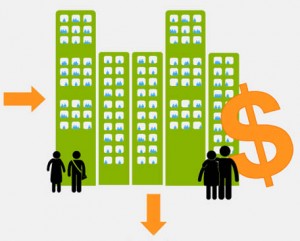For centuries, explorers looked to the stars to help them navigate new worlds. In Baltimore, stargazers aren’t using the night sky to track galaxies explore the Milky Way. Instead, the same modeling and algorithms used to map galaxies is being repurposed for a more pedestrian purpose: urban vacancies. Astrophysicists and city planners are working together to find new ways to manage abandoned buildings and future development. Patterns and Particles As part of an effort to help the city manage housing stock and anticipate residency trends, Baltimore recently partnered with John Hopkins University astrophysicist Tamás Budavári to find a way to detect patterns and predict which parts of the city will thrive, and which areas will end up empty and abandoned. According to Budavári, though astrophysics may have little in common with urban planning, at the core is a fundamental need to detect and detail patterns not readily apparent. “I thought: Can we measure this correlation of clustering of vacant houses the same way we made measurements about astronomy,” Budavári explains in a recent interview with Wired. Data and Diligence Last year, Baltimore Housing Commissioner Michael Braverman contacted Budavári about developing an algorithmic tool capable of predicting the city’s vacancies. Working through the John Hopkin’s Center for Government Excellence (GovEx), Budavári and Braverman are working together to find a proactive approach to the city’s urban planning. The key? Data. GovEx is a three-year program funded by Bloomberg Philanthropies. The goal of the organization involves aiding municipalities with the collection and analysis of data, so that “governments [can] effectively use data in order to make informed decisions on services that improve people’s lives.” The program also connects 120 partner municipalities across the country, helping each city manage data and share strategies. “We can take what we learn,...
Mental Health
+ Urban Architecture
The understanding of our relationship with the built environment continues to evolve. The sustainability movement of the 1970s encouraged construction that conserved earth’s limited resources. In the 1990s, universal design motivated us to create accessible and multi-generational abodes. Now, the psychological ecosystem services movement is exploring the connection between urban environments and mental health. According to the World Health Organization, “one in four people in the world will be affected by mental or neurological disorders at some point in their lives. Around 450 million people currently suffer from such conditions, placing mental disorders among the leading causes of ill-health and disability worldwide.” While treatments are available to address mental health from the inside out, fostering mental well-being from the outside in is also a viable supplement. By understanding how urban spaces affect our mental well-being, we may minimize negative outcomes. Thought leaders Greg Bratman and Agnes van den Berg represent two generations that are forging the path towards urban spaces that nourish the mind. Psychological ecosystem services is a budding field of environmental psychology. Greg Bratman is a PhD candidate in the Emmett Interdisciplinary Program in Environment and Resources at Stanford University. He seeks evidence for the impact of nature experiences on cognitive function, mood, and emotion regulation. The results of his research will be incorporated into urban design and decision-making. Bratman explains, “This knowledge can inform the ways in which urban planners incorporate nature into cities, and provide accessible natural landscapes for urban and suburban residents. It can also provide support for the conservation of open space and wilderness areas in policy design.” For his recent study, Bratman analyzed the rumination patterns (repetitive thought focused on negative aspects of the self) of 38 people. The participants recorded their current levels of rumination and...
Top 20 Cities
For Walkable Urbanism
By now, you’ve probably heard that pedestrian-friendly access is all the buzz among Millennials and hip, active empty nesters. Mortgages and car notes are falling out of favor as these two large portions of the population steer towards rentals in walkable cities such as Seattle, Portland, and New York. A new study shines light on a few cities that are highly walkable and woefully overlooked. “Foot Traffic Ahead: Ranking Walkable Urbanism in America’s Largest Metros,” by Christopher B. Leinberger & Patrick Lynch of The George Washington University School of Business takes a quantitative approach to walkability in urban environments. Researchers evaluated the top 30 metros based upon the 2012 Brookings Institution methodology that pre-defined WalkUPs on geographical and economic terms. The selected cities were evaluated based upon economic performance and social equity performance. The findings were then used to rank the metros by current walkability and projections for walkability in the future. The 30 selected metropolitan areas are home to 46 percent of the population. Those metros also account for 58 percent of the national GDP. Interestingly, only one percent of all metropolitan land classifies as a WalkUP. If one percent seems unreasonably low to you, there is good reason for that. WalkUPs exclude owner-occupied spaces such as universities, medical centers, federal and state government buildings. There is not a consolidated database for such complexes from which researchers could pull information. This means that nearly 30-40 percent of employment spaces were excluded from the study. The current top six metros achieved Level 1 status, demonstrating the best distribution of walkable space in the urban core and surrounding suburbs. Level 1 listings represent 48 percent of all WalkUPs in the US. Within the rankings, cities such as Washington, D.C. outrank hipper destinations like...
A Trendy Infographic
From RentCafe
If you keep an eye on the latest news from the multifamily industry, then you probably already know that apartment renting is the current hot housing option of choice for Americans from all walks of life. The recent recession helped fuel renters’ desires to downsize, cut down on commute times and steer clear of massive mortgages, and the result has been high demand for apartments and low vacancy rates (as well as higher rents). Our friends over at the RentCafe blog, sister site to the apartment leasing service RentCafe, put together this good looking infographic which gives a clear look at who lives in these new renter households, why they’re renting and what these trends mean. The data is clear: the resurgence of renting shows no signs of slowing, and new construction apartment starts are steadily climbing back toward pre-recession levels. The figures are good news for the multifamily industry and could signify a collective shift in our national real estate mindset. What do you think? Will apartment renting stay as popular and trendy as it is today? Or will this be a post-recession reaction that could later reverse? Courtesy of:...




